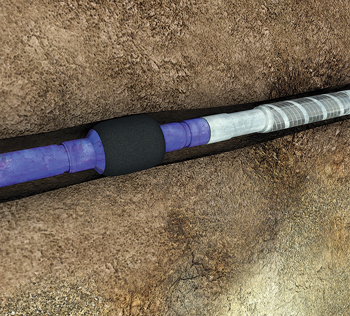PAOLO GAVIOLI and ROBERTO VICARIO, Baker Hughes
The two main advanced completions in horizontal wells are inflow control valve (ICV) and passive inflow control device (PICD) systems. Both of these completions will assist in improving the well production and controlling the undesired fluid breakthrough.
In ICV completions, the openhole packers are installed to create compartments and each compartment is controlled by an ICV. An ICV can be controlled by a hydraulic control line and connected to the surface. The limitation for this completion system is the maximum number of lines (electric and hydraulic) that it is possible to install in each well; the average number of control lines that it is possible to pass through the tubing hanger is eight. If we consider that some of these lines could be needed for chemical injection, downhole gauges and surface-controlled safety valves, the typical maximum number of ICV valves that can be installed in a well is five.
An intelligent production system has the great advantage of allowing an operator to completely shut off a section producing undesired fluids. In most cases, only a few feet of formation producing water or gas forces the production engineer to shut off the entire compartment (500-600 ft of formation). If the same event takes place in different compartments, there is a possibility of losing the oil contribution of most of the openhole section. The best way to overcome this situation is to maximize the number of compartments, which allows us to confine high-productive reservoir sections in between two openhole packers. In the actual technology scenario, the only option to increase the number of compartments is to use a combination of openhole packers and PICDs. PICDs do not need a control line and, combined with the proper feature, like a mechanical sliding sleeve, can be closed to shut off a specific section. The most important concept to use to enhance a PICD system is compartmentalization (Gavioli et al. 2010; Gavioli et al. 2009; Gavioli 2008).
PICD FOR COMPARTMENTALIZATION
In PICD applications, openhole packers are run between sections of PICD to hydraulically separate producing intervals of different characteristics in porosity, permeability or number and size of fractures, in general different productivity indices (PI). When designing a reservoir optimized completion with PICDs, it is generally accepted that the ICD pressure setting and the number of compartments should increase when little wellbore information is available and heterogeneity or wellbore complexity increases (Gavioli 2008), Fig. 1.
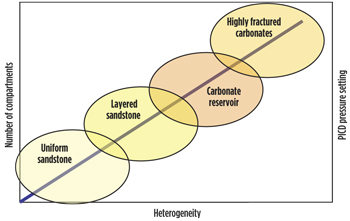 |
| Fig. 1. Empirical relation between the number of compartments needed and the type of reservoir where the completion is run. |
|
In an openhole completion, each feature of heterogeneity, in order to be controlled, should be trapped in a short compartment and produced through a reduced number of PICD units. This is true, except in the case of a perfectly collapsed annulus condition. This condition, though, can never occur in a carbonate reservoir and rarely happens in sandstone. In fact, since the annulus is open to flow, this will be the path of least resistance for the fluid after entering the wellbore from the reservoir because the completion creates a resistance to fluid (pressure drop) that, even if minimal, it is still enough to divert the flow in all directions in the annulus before entering the completion. If severe heterogeneities are present, the reservoir-to-wellbore flow will be dominated by those heterogeneities, minimizing the benefits of a PICD completion. This phenomenon cannot be detected by running a production log tool (PLT), which most likely will show a perfect inflow profile in an ICD completion. In fact, what is seen in a PLT is the oil influx from the annulus to the completion, and events at the formation face are masked by the completion itself. Interestingly, a completion with no packers at all will show a better profile in a PLT due to the fluid entering the wellbore and flowing freely in the annulus before entering the completion, so the equalization will happen only between the annulus and completion, leaving the high PI zones free to dominate production in the annulus. For these reasons, there is not an easy method to show the importance of compartments in case of dry oil production, because the production logs currently in use to assess this kind of completion performance will not yield the desired information. The scenario described above changes when water or free gas starts arriving into the wellbore.
Similar conclusions can be reached by taking into account the mobility and the possible entry points for undesired fluids, Fig. 2. Intuitively, the more entry points and the smaller (or discrete) are those entry points of undesired fluid, the more compartments will be required in order to control those heterogeneities. In this scenario, it will be beneficial for future water cut and free gas/oil ratio (GOR) control to force the undesired fluids to be produced from a minimum number of PICDs. The best way to obtain this effect is to guarantee that each compartment will include only one PICD. It will be necessary to maximize the number of openhole packers to have the number of compartments equal to the number of PICD units designed for the considered well.
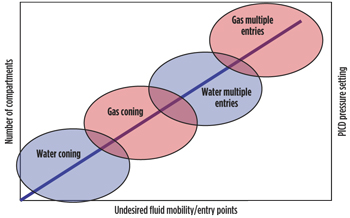 |
| Fig. 2. Empirical relation between the number of compartments needed and the type of undesired produced fluid where the completion is run. |
|
At this point, assuming that undesired fluids are produced by some high PI portion of the pay and not from the entire pay, the domination of high PI features will be detected even by looking to the production data. In this case, the presence and number of compartments will play a critical role. Generally speaking, increasing the number of compartments results in better control of both water and free gas production. This performance has been extensively proven by both simulation and field results.
In Fig. 3, the effect of number of compartments in controlling water is shown. The data shown in the figure are from a carbonate field in Saudi Arabia. The water cut of each well experiencing water production in a certain area after at least one year of production has been plotted against the number of compartments in the well. The derived trend line approaches the theoretical expected behavior of an inversely proportional relationship between water cut and number of zones. Based upon this behavior and based upon the suspected mechanism of water production in a well (fractures, coning, fingering, etc.), the design of the optimum number of compartments can be established.
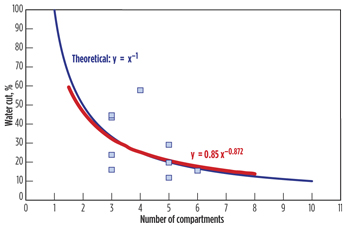 |
| Fig. 3. Effect of compartmentalization in water control. |
|
For free gas control, the number of compartments required to reach an optimum control is intuitively higher than in the water case due to higher gas mobility, Fig. 4. The data shown are obtained by simulation of a well in a North Africa field. The assumption is that in a 1,500-ft wellbore, a 50-ft section is gassed out completely, and the annulus is fully open. In a scenario with ICD but no packers, the gas greatly dominates in the annulus due to the favorable mobility ratio. The GOR rapidly decreases with the addition of compartments and traps the gas-producing zone into smaller and smaller sections. All this is assuming that the position of the gas-producing section is not known and the compartments are all equal in length and include the same number of PICD units. The two lines represent two different ICD settings, the red being a double pressure drop through the ICD for the same rate compared to the blue. There is a GOR reduction by using a different PICD flow resistance rate, but the GOR reduction effect is much stronger by adding compartments than by increasing the pressure drop into the ICD. This information is usually obtained from measurements, logs and production data available for a given well. These data will allow identification of the areas of the well where water coning or gas cusping could take place and properly design the PICD completion. To conclude, the customization of this kind of completion is not recommended unless a deep knowledge of the well PI is known. Figure 5 shows that the more information available, the less need of fine compartmentalization.
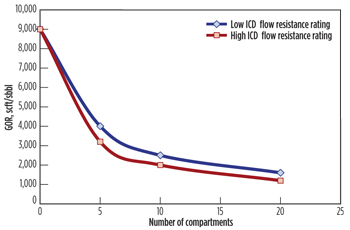 |
| Fig. 4. Effect of compartmentalization in gas control. |
|
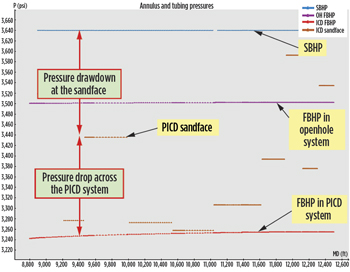 |
| Fig. 5. Empirical relation between the number of compartments needed and the type of available wellbore data where the completion is run. |
|
WELL SIMULATION
To demonstrate the benefits of compartmentalization in a PICD openhole completion and its effects on the final water cut/GOR, a 3,500-ft horizontal well was simulated and sensitivities were run on the number of compartments. A commercial steady-state near-wellbore and wellbore hydraulics simulator was used (Halliburton, 2011). While not being a reservoir simulator, the simulator can calculate individual well performance using reservoir properties at a specified moment in time. These results are for initial completion character or for specific scenarios (water and gas break through), and do not necessarily represent the improvements that may or may not be achieved over the life of the completion. To calculate production profiles over time, a reservoir simulator would be needed. However, in order to obtain meaningful results with a dynamic reservoir simulator, the reservoir model has to feature a very fine grid, able to take into account detailed reservoir properties and other punctual heterogeneities (i.e., fractures, high perm streaks, etc.). Such models are very difficult to obtain. For these practical reasons, a more simplified approach was preferred by using only a steady-state near-wellbore simulator, where a finer description of the reservoir properties along the wellbore can be easily achieved and quickly changed for sensitivity testing. The steady-state simulator has been used to evaluate productive well performance at bottomhole conditions obtaining three different kinds of plots:
-
Pressure plot to compare static bottomhole pressure (SBHP) with tubing flowing bottomhole pressures (FBHP). When the PICD system is simulated, an additional line is plotted in this graph: PEQ Sandface. This line is very helpful to allocate the pressure drawdown at the reservoir sandface and the pressure drop across the PICD system. Figure 6 shows a typical pressure plot.
-
Oil/gas/water flow rate plots show the cumulative production rate along the openhole section. Using these plots, it is possible to compare the water cut and the total GOR in barefoot and PICD completions. These graphs represent the PLT profile based on simulation reservoir pressure, fluid characteristics and permeability profile.
-
Oil/gas/water flux plots show the specific rate (bbl/day/ft) along the open hole. These plots are very helpful to evaluate the effect of compartmentalization in conjunction with PICD system compared to barefoot completion. The higher the numbers of compartments, the better the fluid rate equalization effect at the sandface. The flow rate plots are not sufficient to affirm that the flow rate is equalized. A perfect strait line in a PLT plot could be evidence that the openhole packers are not sealing against the formation, especially in heterogeneous formations.
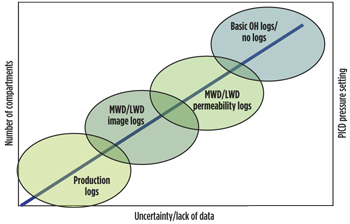 |
| Fig. 6. Typical pressure plot output from steady state near wellbore simulator. |
|
The reservoir pressure is 3,000 psi, oil gravity 32°API and gas gravity 0.88 sg to air. As per the permeability profile in Fig. 7, the average wellbore permeability is 350 mD with a major fracture at 8,500 ft. This fracture will be the hot spot to experience early gas/water breakthrough in the well.
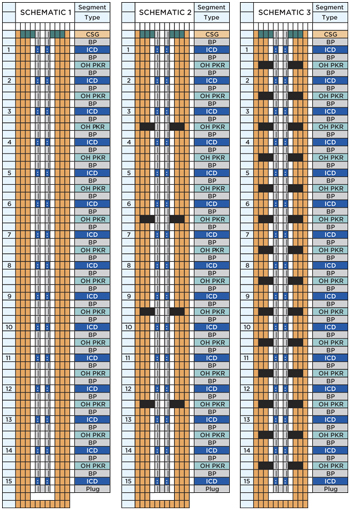 |
| Fig. 7. Permeability profile. |
|
If higher-viscosity oil is simulated, the effect of compartmentalization on water control will be even more evident. In fact, the higher the mobility of the undesired fluid, the higher should be the number of compartments in order to control that fluid after breakthrough. In a heavy-oil environment, water production has a similar effect (in term of flow domination) to the free gas production in a light oil well. The case presented here, with 32°API oil, is conservative in terms of severity of water domination. For this well simulation, water and gas breakthrough effects have been analyzed separately to better underline the effects of the compartmentalization in case of gas or water production due to the fracture. The simulated oil rate is 5,000 bopd.
The simulation has been run considering four different completion setups:
-
Barefoot completion (this could be a slotted liner of a standalone screen and the effect would be the same— no pressure drop through the completion).
-
PICD completion without openhole packers.
-
PICD completion with 4 openhole packers (5 compartments).
-
PICD completion with 14 openhole packers (15 compartments).
And two scenarios:
-
Water breakthrough in the fracture (or high-permeability streak), Scenario 1.
-
Gas breakthrough in the fracture (or high-permeability streak),
Scenario 2.
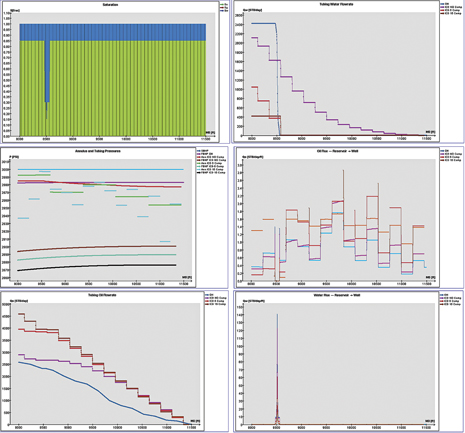 |
| Scenario 1. Water breakthrough |
|
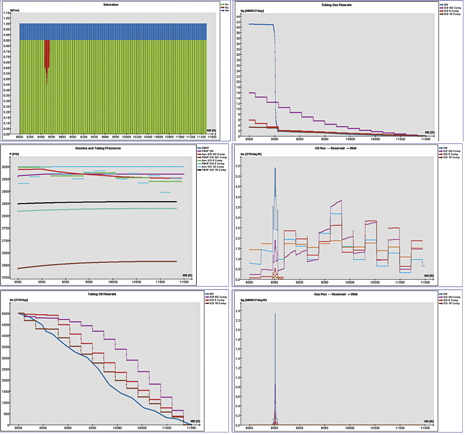 |
| Scenario 2. Gas breakthrough |
|
The three schematics for the PICD completions are presented in Fig. 8. In all the PICD completions, the optimized number of PICD units based on reservoir properties, well PI and well production, is 15. In this paper we will not go into the reasons why 15 PICDs have been selected and we will take this as a given, since this topic has been extensively discussed in the literature, especially in recent papers discussing the best practices and guidelines for PICD completions design (Gavioli et al. 2010, 2009).
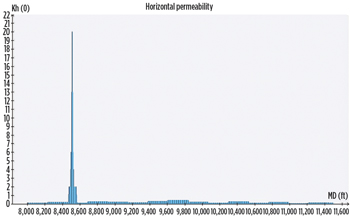 |
| Fig. 8. Well schematics: 1) no compartmentalization; 2) 5 compartments; and 3) 15 compartments. |
|
From the summary in Table 1, it is clear that having a PICD completion in the well, with no packers (assuming that the annulus has not been packed), will not help greatly in controlling the water after breakthrough. PICD will still help in eliminating annular flow and in equalizing the production along the horizontal, but the ability to control water will be almost insignificant if packers are not run along with the completion. When packers are run, there is a clear trend of a positive relationship between the reduction of water cut and the number of compartments. The optimum is reached when the number of compartments is maximumized, when there is only one PICD per compartment. It is important to note the assumption that the water-producing zone is not known and the same results would have been obtained if the high-permeability section was in a different position along the horizontal. This result reinforces the previous discussion about the relation between the number of compartments and uncertainty about the well or lack of data.
| Table 1. Water breakthrough summary results |
|
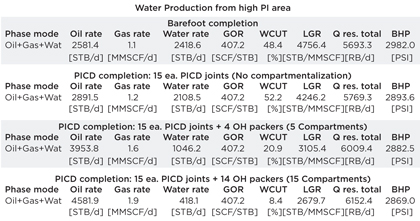
|
From the summary in Table 2, it is clear that having a PICD completion in the well, with no packers (assuming that the annulus has not been packed) again, as shown for the water, will help in controlling the free gas after breakthrough but not as much as if packers are run along with the completion. The behavior in the gas scenario is slightly different than with water because even a small restriction in the completion is sufficient to restrict some gas production, even if packers are not run. This is assuming that total liquid surface rate is maintained constant. When packers are run, there is a clear trend of positive relationship between the reduction of free gas and the number of compartments. The optimum is reached when the number of compartment is maximum, which means when there is only one PICD per compartment.
| Table 2. Gas breakthrough summary results |
|
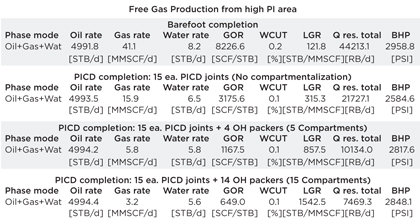
|
It is also very important to note that, as we did for water, the assumption is the gas-producing zone is not known and the same results would have been obtained if the high-permeability section was in a different position along the horizontal. This goes back to reinforce what has been previously discussed with regard to relation between number of compartments and uncertainty about the well or lack of data.
Recently, a new PICD feature has become available to mechanically shut off the units producing undesired fluids. In this case, a PLT will identify the PICD units producing gas or water. Using a rigless CT operation, it will be possible to close the desired PICD. A hybrid PICD-ICV system will be the perfect solution for future advanced completions. As such, it will be possible to merge the benefit of the two field-proven technologies in a single “intelligent” tool.
CONCLUSIONS
Openhole packers have been proven to be very effective in many different applications, including curing losses, controlling high-permeability zones and fractures, improving equalization in passive and active ICD completions, and, most importantly, controlling water and gas production. The usage of these tools has increased exponentially in the last few years and will continue to grow.
A significant amount of best practices came from the extensive run history and lessons learned and it has been found that openhole packers often play the most critical role for a completion’s success. In addition, the availability of a wide range of new zonal isolation tools on the market makes it easier for operators to obtain the best and most cost-effective solution for each application.
Openhole packers for compartmentalization in these completions are keys for success and offer benefits for inflow and annulus flow control. An important consequence is the ability to control gas and/or water after breakthrough. This has been proven from analyzing a significant amount of production logs post installation. Some results have been shown here along with simulations to theoretically prove what has been extensively proven in practice. These results are for initial completion character or for specific points in time (water and gas break-through), and do not necessarily represent the improvements that may or may not be achieved over the life of the completion. This is a limitation of this paper, which could be improved by using a dynamic reservoir simulator.
KEY FINDINGS
Key findings that have become standard best practices for most vendors and operators are the following:
-
Many factors contribute to the justification of increased number of compartments. These include reservoir heterogeneity, high PI contrasts along the well and higher mobility of undesired fluid.
-
The less data available to characterize the wellbore and reservoir properties, and the higher the uncertainty, the higher should be the number of compartments used. In this regard, uncertainty should be treated as heterogeneity. So a probabilistic approach should be used to fix any potential problem that may arise from the lack of knowledge, hence the need to maximize the number of compartments.
-
In a real-life situation, there are at least two key practical factors that limit the number of compartments that can be used. One is a cost to benefit relationship. The other is a shear reduction in the length of open intervals due to the packers sealing area that is isolating productive formation (especially for sandstone formations).
-
Simulations can be used in order to find the optimum number of packers compromising cost/benefits and reservoir exposure. 
ACKNOWLEDGMENTS
Special thanks to Ed Wood and Fredrik Harestad for their help and valuable contributions. This article is adapted from SPE 132846 “The evolution of the role of openhole packers in advanced horizontal completions: From novel technology to a critical key to success,” presented at the SPE Asia Pacific Oil & Gas Conference held in Brisbane, Queensland, Australia, Oct. 18-29, 2010.
| NOMENCLATURE |
| BHP |
Bottomhole pressure |
| CT |
Coiled tubing |
| ECP |
External casing packer |
| FBHP |
Flowing bottomhole pressure |
| GOR |
Gas/oil ratio |
| ICD |
Inflow control device |
| ICV |
Inflow control valve |
| OH |
Openhole |
| PI |
Productivity index |
| PICD |
Passive inflow control device |
| PLT |
Production logging tool |
| SBHP |
Static bottomhole pressure |
| WBI |
Wellbore isolation |
| WC |
Water cut |
LITERATURE CITED
1. Al Arfi, S. A., S. El Abd Salem, A. Al-Saiid Keshka, S. Al-Bakr, A. H. Amiri, A. Y. El-Barbary, M. Elasmar and O. Y. Mohamed. Inflow Control Device an Innovative Completion Solution, from Extended Wellbore to Extended Well Life Cycle, paper IPTC 12486, presented at IPTC, Kuala Lumpur, December 2008.
2. Al Qudaihy, D. S., F. N. Nughaimish, A. H. Sunbul, A. A. Ansari, D. E. Hembling, O. A. Faraj and B. A. Voll. New-Technology Application to Extend The Life of Horizontal Wells By Creating Uniform-Flow-Profiles: Production Completion System: Case Study, paper SPE 85332, presented at the SPE/IADC Middle East Drilling Technology Conference & Exhibition held in Abu Dhabi, UAE, Oct. 20-22, 2003.
3. Al Qudaihy, D. S., H. B. Al Qahtani, A. H. Sunbul, D. Hembling and G. Salerno. The Evolution of Advanced Well Completions Results in Enhanced Well Productivity and Recovery in Saudi Aramco’s Offshore Fields, paper IADC/SPE 103621, presented at the IADC/SPE Asia Pacific Drilling and Technology Conference, Bangkok, Nov. 13-15, 2006.
4. Gavioli, P., The Role of Open Hole Packers for Completion Operations In Saudi Arabia, Saudi Oil&Gas Journal, July 2008.
5. Gavioli, P., G. A. Garcia, and J. C. Serrano. Design, Analysis, and Diagnostics for Passive Inflow Control Devices With Open hole Packer Completions, paper OTC 20348, presented at the 2010 Offshore Technology Conference, Houston, Texas, May 3–6, 2010.
6. Gavioli, P., R. Vicario and G. DantoniaReservoir-Optimized Completions in Middle East Carbonate Reservoirs: Passive Inflow-Control Devices and Open hole Packer Design Procedure Considerations, paper SPE, presented at the SPE Saudi Arabia Section Technical Symposium and Exhibition held in Al Khobar, Saudi Arabia, May 9–11, 2009.
7. Halliburton, NETool, 2011. http://www.halliburton.com/ps/Default.aspx?navid=1860&pageid=4575
8. Hembling, D., A. H. Sunbul and G. Salerno. Advanced Well Completions Result in Enhanced Well Productivity and Recovery in Saudi Aramco’s Offshore Fields, paper SPE 108877 presented at the 2007 SPE APOGCE, Jakarta, Oct 30. –Nov. 1, 2007.
9. Henriksen, K. H., J. Augustine, and E. Wood. Integration of New Open Hole Isolation Technology Contributes to Improved Oil Reserves Recovery and Revision in Industry Best Practices, paper SPE 97614, presented at the SPE IOR Conference Asia Pacific, Kuala Lumpur, Dec. 5-6, 2005.
10. Krinis, D., N. Al-Dawood and Y. Soremi. Horizontal Well Performance Optimization Using Linearized Inflow Control Devices, paper SPE 117213 presented at the Abu Dhabi International Petroleum Exhibition and Conference, Abu Dhabi, Nov. 3-6, 2008.
11. Lyngra, S., D. Hembling, T. M. Al-Zahrani, U. F. Al-Otaibi, H. S. Al-Marhoun and A. B. Anderson. A Case Study of the Application of Slim-Hole Passive Inflow Control Devices to Revive Wells with Tubular Limitations in a Mature Fields, paper SPE 105624 presented at the 2007 Middle East Oil&Gas Show and Conference, Bahrain, March 11-14, 2007.
12. McIntyre, A., R. Adam, J. Augustine and D. Laidlaw. Increasing Oil Recovery by Preventing Early Water and Gas Breakthrough in a West Brae Horizontal Well: A Case History, paper SPE 99718, presented at the 2006 SPE/DOE Symposium on Improved Oil Recovery held in Tulsa, Oklahoma, U.S.A., April 22–26, 2006.
|
The authors
|
| PAOLO GAVIOLI is the Engineering and Technology Manager for Completion and Production at Baker Hughes. Mr. Gavioli is based in Al Khobar, Saudi Arabia. He began his career in 2002 at Eni E&P in Milan as the Production Optimization Engineer working on sand control, well stimulation and water shut-off. He holds a masters degree in petroleum engineering from Politecnico di Milano University in Italy, and a masters degree in chemical engineering from Ecole Polytechnique of Montreal, Canada. |
|
| ROBERTO VICARIO is the Reservoir Optimized Completions Manager for Baker Hughes, based in Al Khobar, Saudi Arabia. Mr. Vicario began his career in 2003 at Eni E&P in Milan as the Production Optimization Engineer working on sand control, well stimulation and water shut-off. He holds a masters degree in chemical and petroleum engineering from Politecnico di Milano University in Italy. |
|

